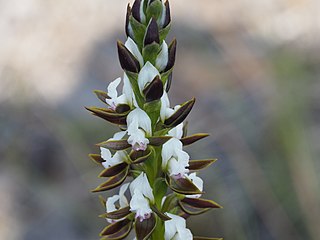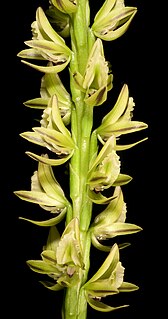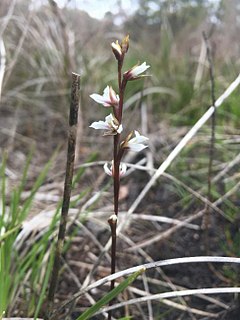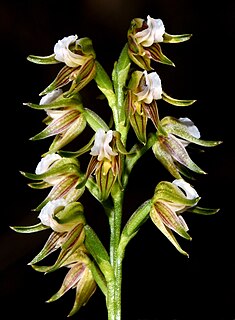
Prasophyllum sargentii, commonly known as the frilled leek orchid, is a species of orchid endemic to the south-west of Western Australia. It is a tall orchid with a single smooth, tubular leaf and up to thirty or more purplish and white or golden brown and white flowers with a frilled labellum.
Prasophyllum australe, commonly known as the southern leek orchid or austral leek orchid, is a species of orchid and is endemic to south-eastern Australia. It has a single tubular, green leaf and up to fifty scented, greenish-brown flowers with red stripes.

Prasophyllum fimbria, commonly known as the fringed leek orchid, is a species of orchid endemic to the south-west of Western Australia. It is a tall orchid with a single smooth, tube-shaped leaf and up to seventy greenish-brown flowers with a white and pink labellum.

Prasophyllum odoratum, commonly known as the fragrant leek orchid, Rogers scented leek orchid or sweet leek orchid is a species of orchid endemic to south-eastern Australia. It has a single tubular leaf and up to fifty fragrant green and white flowers with reddish marks.

Prasophyllum brownii, commonly known as the Christmas leek orchid, is a species of orchid endemic to the south-west of Western Australia. It is one of the last of the genus in Western Australia to flower and has a tall flowering stem with up to eighty pale green and fawn-coloured flowers.
Prasophyllum candidum, commonly known as the Kiandra leek orchid, is a species of orchid endemic to eastern Australia. It has a single tubular, yellowish-green leaf and up to forty scented, bright white to greenish flowers. It grows in subalpine areas at altitudes above 1,000 m (3,000 ft) in New South Wales and Victoria although in the latter state it is considered to be a form of P. odoratum.
Prasophyllum cucullatum, commonly known as the hooded leek orchid, is a species of orchid endemic to the south-west of Western Australia. It is a tall orchid with a single smooth, tubular leaf and up to fifty or more purplish-red and white flowers with a frilled labellum crowded along a relatively short flowering stem.

Prasophyllum cyphochilum, commonly known as the pouched leek orchid, is a species of orchid endemic to the south-west of Western Australia. It is a relatively common orchid with a single smooth, tubular leaf and up to thirty or more pale yellow and brown flowers. The flowers do not open fully, are more or less cup-shaped and have a "humped" labellum.
Prasophyllum drummondii, commonly known as the swamp leek orchid, is a species of orchid endemic to the south-west of Western Australia. It is a late-flowering species with a single tubular leaf and up to thirty brownish-orange or pale yellow flowers and often grows in standing water.
Prasophyllum gibbosum, commonly known as the humped leek orchid, is a species of orchid endemic to the south-west of Western Australia. It is a late-flowering leek orchid with a single smooth, tubular leaf and up to eighty or more purplish-red and white flowers with a smooth labellum. It is similar to P. cucullatum but that species has a frilly labellum, usually a shorter flowering stem and an earlier flowering period.
Prasophyllum giganteum, commonly known as the bronze leek orchid, is a species of orchid endemic to the south-west of Western Australia. It is a tall, fragrant leek orchid with a single smooth, tubular leaf and up to fifty or more green and pinkish-purple flowers with a frilly labellum.

Prasophyllum hians, commonly known as the yawning leek orchid, is a species of orchid endemic to the south-west of Western Australia. It is a common, tall leek orchid with a single smooth, tubular leaf and up to fifty or more pink and fawn flowers with a frilly labellum.
Prasophyllum macrotys, commonly known as the inland leek orchid, is a species of orchid endemic to the south-west of Western Australia. It has a single tubular leaf and up to thirty greenish to purplish flowers and is similar to the tall leek orchid but has smaller, darker flowers.

Prasophyllum parvifolium, commonly known as the autumn leek orchid, is a species of orchid endemic to the south-west of Western Australia. It is a common species in its range and has a single smooth, tube-shaped leaf and up to eighteen or more green and white flowers with red stripes.
Prasophyllum ovale, commonly known as the little leek orchid, is a species of orchid endemic to the south-west of Western Australia. It is a small leek orchid with a single smooth, tubular leaf and up to twenty or more white, green and brown flowers with the labellum only slightly upturned.

Prasophyllum patens, commonly known as the broad-lipped leek orchid or sandstone leek orchid, is a species of orchid endemic to the Sydney region of New South Wales. It has a single tubular green leaf and up to thirty green to greenish-brown, lemon-scented flowers with a white labellum.
Prasophyllum paulinae, commonly known as Pauline's leek orchid, is a species of orchid endemic to the south-west of Western Australia. It is a small, rare leek orchid with a single smooth, tubular leaf and up to seventy yellowish-green and purple flowers.
Prasophyllum plumiforme, commonly known as the dainty leek orchid, is a species of orchid endemic to the south-west of Western Australia. It is a small leek orchid with a single smooth, tubular leaf and up to fifty or more tiny cream-coloured or greenish-yellow flowers on a tall flowering stem.
Prasophyllum regium, commonly known as the king leek orchid, is a species of orchid endemic to the south-west of Western Australia. It has a single, unusually thick tubular leaf and up to one hundred relatively large, greenish-brown or burgundy-coloured flowers. It is one of the tallest leek orchids, sometimes growing to a height of 2 m (7 ft).

Prasophyllum basalticum is a species of orchid endemic to New South Wales. It has a single tubular, dark green leaf and up to fifteen scented, greenish-brown to brownish-red flowers with a white and green labellum. It grows in grassy woodland on the Northern Tablelands.



















